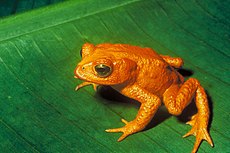Extinction

| Conservation status | |
|---|---|
 | |
| Extinct | |
| Threatened | |
| Lower Risk | |
Other categories | |
| |
Related topics | |
 Comparison of Red list classes above and NatureServe status below  | |
| Part of a series on |
| Evolutionary biology |
|---|
 |
Extinction is when a species of animal, plant, or other organisms are no longer living or dies. Extinction is one of the major features of evolution.[1]
All species become extinct sooner or later. The end of a species may happen for many reasons. It may be caused by habitat loss or by being overhunted, or by a major extinction event. An example of an animal that is now extinct is the Dodo, from over-hunting. Another quite different way for a species to end is by species-splitting, known as cladogenesis. The species living today probably were not living in the Cambrian period, but their ancestors were.
Notable extinct animal species include the non-avian dinosaurs, the saber-toothed cats, the dodo, the mammoths, ground sloths, the thylacine, the trilobites and the golden toad.
Endangered species are those which may become extinct. A report from Kew Gardens suggests that one fifth of plant species may be at risk of extinction.[2] Fossil species sometimes reappear millions of years after they were thought to be extinct. These cases are called Lazarus taxa. Humans are to blame due to cutting down animals’ natural habitat such as forests.
Duration of species
[change | change source]The average duration of species varies according to the groups studied. A study of benthic (deep water) foraminifera showed an average of 16 million years if they lived above 200 metres, but 25my if they lived below 200 metres.[3] On the other hand, the average survival time for mammalian species over the past 20my has been 2.33my.[4][5]
It is estimated that 99.9% of all species that have ever lived are now extinct.[6][7] More than half of the plants and animals that have become extinct in the last 200 years have been in Australia. There the arrival of Europeans with (accidentally or deliberately) introduced species has damaged the native biota. Especially, the introduction of eutherian mammals has caused the extinction of many marsupial forms.
Duration of higher groups
[change | change source]This section does not have any sources. (December 2020) |
Naturally, higher categories such as genera, families, orders, classes and phyla last longer, because they are composed of more species. As far as we know, no phylum has gone completely extinct since the Cambrian, but quite a few classes went extinct in one or other of the 'big five' extinction events. Examples of higher categories of animal now extinct are: placoderm fish, trilobites, ammonites, pelycosaurs, non-avian dinosaurs, pterosaurs, ichthyosaurs and plesiosaurs.
Reasons
[change | change source]Darwin thought that most extinctions occurred because some organisms became more effective, and replaced their less advanced competitors. No doubt that does occur, but the view now is that environmental change is more important. Organisms become adapted to the environments they live in. The environment certainly does change, and sometimes quite dramatically. When it does, some organisms can adapt to the changes. Others cannot.
The Earth's environment can stay rather stable for long periods of time. Then the rate of extinction is usually quite low. Then changes occur, sometimes quite rapidly. In these times the rate of extinction can be much higher. The rate of extinction is therefore a useful thing to measure.[8]
Related pages
[change | change source]References
[change | change source]- ↑ When talking about volcanos, "extinct" means that the volcano is no longer active. When talking about languages, "extinct" mans that it is no longer in use.
- ↑ One in five of world's plant species at risk of extinction 2016 May 10 The Guardian
- ↑ Bozas M.A. & Culver S.J. 1984. Species duration and evolution: benthic forms on the Atlantic continental margin of North America. Science 225, 829–230.
- ↑ K.J. Willis, E.S. Vrba and D. DeGusta 2004. Do species populations really start small? New perspectives from the Late Neogene fossil record of African mammals. Phil Trans Roy Soc B359, 285–293. [1]
- ↑ Vrba E.S. 2000. Major features of Neogene mammalian evolution in Africa. In T.C. Partridge & R. Maud (eds) Cenozoic geology of southern Africa. Oxford. pp 277–304
- ↑ Newman, Mark. 1994. "A mathematical model for mass extinction". Cornell University. Retrieved July 30, 2006.
- ↑ Raup, David M. 1991. Extinction: bad genes or bad luck? W.W. Norton, New York.
- ↑ Lawton J. and May R. 1995. Extinction rates. Oxford University Press.
Other websites
[change | change source]- Extinction at Peripatus.gen.nz
- Extinction -Citizendium
